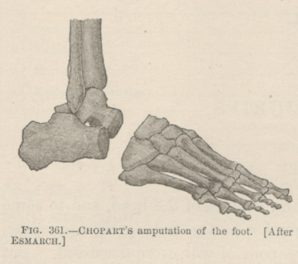Title: Miller, J.
Source text: The Medical and Surgical History of the War of the Rebellion. (1861-65.), Part 3, Volume 2 (Washington, DC: Government Printing Office, 1883), 629.
Civil War Washington ID: med.d2e24320
TEI/XML: med.d2e24320.xml
CASE 924.—Private J. Miller, Co. E, 6th Pennsylvania Reserves, aged 20 years, was wounded in the right foot, fracturing the bone, at Fredericksburg, December 13, 1862. He was admitted to the field hospital of the 3d division, First Corps. Surgeon C. Bower, 6th Pennsylvania Reserves, reported that he performed "amputation at the tarsus" on the day of the injury. Acting Assistant Surgeon H. Hirschfield reported the progress of the case as follows: "The patient was admitted to Harewood Hospital at Washington ten days after being wounded. Chopart's amputation had been performed on the field. On December 27th, when the case was first seen by me, there was much suppuration and the wound seemed to be drawn open, by the tendo-achillis. I applied a splint to correct the tension and at first used cold water and afterwards warm dressings; tonics and stimulants were administered. By January 20, 1863, the wound had nearly healed and dry lint and bandages were used. A small abscess had appeared at the ankle and had been opened. About February 15th this opening became gangrenous and the leg in this locality swelled up to an enormous size the abscess, which originally was only two inches long, growing into a large sore of circular shape three and a half inches in diameter. All the tissues and even the periosteum were destroyed. Healthy granulations, however, were finally brought out, and the part was healing but could not close up on account of necrosis in part of the tibia. While the healing process of the neighboring parts was progressing favorably, erysipelas set in and spread from the foot to nearly up to the knee, being attended by excessive sloughing of the original abscess. This soon passed off, however, and after a few days the wound again became healthy in appearance, decreased in extent, and the leg resumed its natural size rapidly. Things now went on favorably again for a time, when severe pain indicated another collection of matter above the line of the affected tibia and towards the middle of the leg, which was relieved by an incision two inches in length into the periosteum, giving free exit to the confined pus. This last opening healed up readily, and by June 1st nature had completed the exfoliation of the cortical substance of the tibia, which I removed four inches in length. The wound now healed up very rapidly, but several days afterwards gangrene re-appeared and continued up to June 10th. Poultices were continued in the mean time and the treatment was adapted to the exigencies of the case. During the progress of the case the patient's general condition, which was very good now, had varied according to the several complications, being sometimes very low and prostrated from hectic and diarrhœa, but always reacting rapidly. On June 14th healthy granulations once more showed themselves, and by July 8th the wound had closed up to the size of a two-shilling piece. Ten days later it was healed entirely, the patient's general condition being excellent." He was discharged from service September 4, 1863, and pensioned, and one year afterwards he was supplied with an artificial foot by the Palmer Arm and Leg Co. of Philadelphia. The pensioner was paid June 4, 1880.
